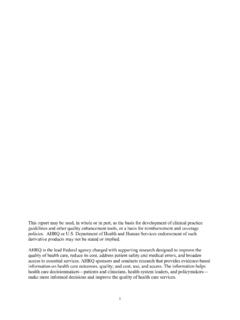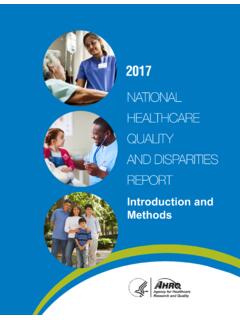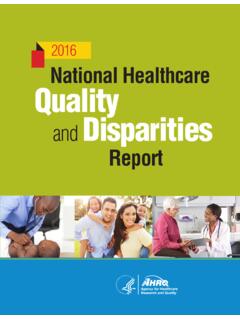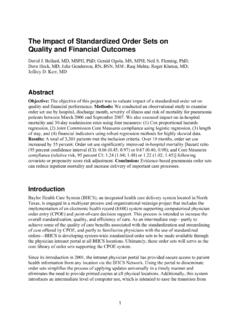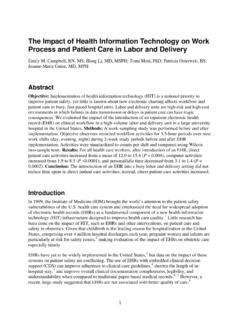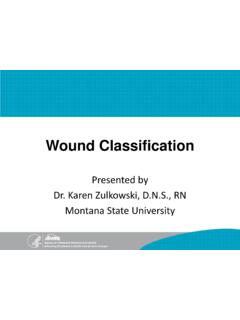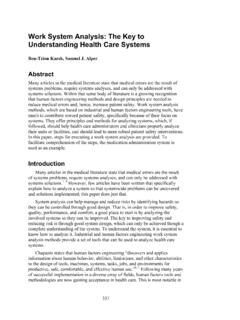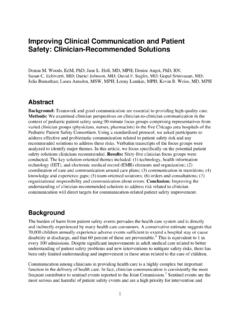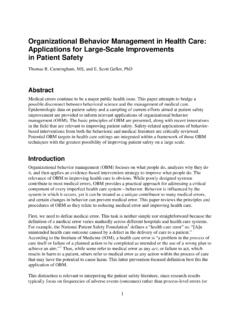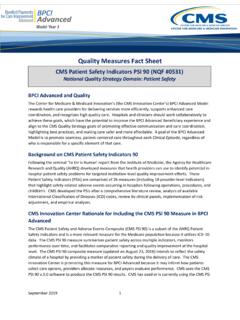Transcription of AHRQ Quality Indicators Fact Sheet
1 AHRQ Quality Indicators Toolkit Fact Sheet on Inpatient Quality Indicators What are the Inpatient Quality Indicators ? The Inpatient Quality Indicators (IQIs) include 28 provider-level Indicators established by the Agency for Healthcare Research and Quality (AHRQ) that can be used with hospital inpatient discharge data to provide a perspective on Quality . They are grouped into the following four sets: Volume Indicators are proxy, or indirect, measures of Quality based on counts of admissions during which certain intensive, high-technology, or highly complex procedures were performed. They are based on evidence suggesting that hospitals performing more of these procedures may have better outcomes. Mortality Indicators for inpatient procedures include procedures for which mortality has been shown to vary across institutions and for which there is evidence that high mortality may be associated with poorer Quality of care.
2 Mortality Indicators for inpatient conditions include conditions for which mortality has been shown to vary substantially across institutions and for which evidence suggests that high mortality may be associated with deficiencies in the Quality of care. Utilization Indicators examine procedures whose use varies significantly across hospitals and for which questions have been raised about overuse, underuse, or misuse. Mortality for Selected Procedures and Mortality for Selected Conditions are composite measures that AHRQ established in 2008. Each composite is estimated as a weighted average, across a set of IQIs, of the ratio of a hospital s observed rate (OR) to its expected rate (ER), based on a reference population: OR/ER. The IQI-specific ratios are adjusted for reliability before they are averaged, to minimize the influence of ratios that are high or low at a specific hospital by chance.
3 Users may select from among several weighting options. The composite Indicators are intended to be used primarily to monitor performance in national and regional reporting, and also for comparative reporting and Quality improvement at the provider level. They are not intended to reflect any broader construct of Quality , beyond that reflected in the component Indicators . A Snapshot of the Indicators The current provider-level IQIs are listed in Table 1, along with information on their annual rates of incidence and status regarding endorsement by the National Quality Forum. A detailed Guide to Inpatient Quality Indicators , software for calculating the measures, and software documentation are available on the AHRQ QI Web site: The guide includes a summary assessment for each of the individual Indicators .
4 Each year, AHRQ updates the IQIs to reflect changes to the International Classification of Diseases, 9th Revision, Clinical Modification and Diagnosis-Related Group coding specifications, specifications of the Indicators themselves, data elements reported in the Uniform Billing form, and other technical changes. Other revisions also are made to the Indicators from time to time, as determined by continued analysis of the Indicators and review by expert panels. All the changes made are described in an online change log on the AHRQ QI Web pages. Tool AHRQ Quality Indicators Toolkit Table 1. The 2013 Provider-Level Inpatient Quality Indicators , With 2011 Rates and National Quality Forum Endorsement Status NQF Endorsement IQI indicator Rate per 1, 000 ID Year Volume Indicators 1 Esophageal resection NA 0361 2008 2 Pancreatic resection NA 0366 2008 4 Abdominal aortic aneurysm (AAA) repair NA 0357 2008 5 Coronary artery bypass graft (CABG) NA 6 Percutaneous coronary intervention (PCI) NA 7 Carotid endarterectomy (CEA) NA Mortality Rates for Inpatient Procedures 8 Esophageal resection 0360 2008 9 Pancreatic resection 0365 2008 11 AAA repair 0359 2008 12 CABG 13 Craniotomy 14 Hip replacement 30 PCI (not used in public reporting) 31 CEA (not used in public reporting) Mortality Rates for Inpatient Conditions 15 Acute myocardial infarction (AMI)
5 0730 2010 32 AMI, without transfer cases 16 Heart failure (CHF) 0358 2008 17 Acute stroke 0467 2008 18 Gastrointestinal hemorrhage 19 Hip fracture 0354 2008 20 Pneumonia 0231 2007 Utilization Rates 21 Cesarean delivery, uncomplicated 33 Primary cesarean delivery, uncomplicated 22 Vaginal birth after cesarean (VBAC), uncomplicated 34 VBAC, all 23 Laparoscopic cholecystectomy 24 Incidental appendectomy in the elderly 25 Bilateral cardiac catheterization 0355 2008 Source: Healthcare Cost and Utilization Project, Nationwide Inpatient Sample, 2011. AHRQ Quality Indicators Software AHRQ provides free software in both SAS and Windows for organizations to apply the IQIs to their own data to assist Quality improvement efforts in acute care hospital settings. Both versions contain all the AHRQ QI modules, including the IQIs.
6 Both versions of the software include the IQI composites. Included in the software are data that allow hospitals to compare their measures to national benchmarks, based on data from the State Inpatient Databases (SID). The most recent release of the software uses the most current data available from the SID for computation of benchmarks, which is a change from previous versions that had used 3-year averages. The mortality Indicators can be risk adjusted, but utilization and volume are not. Tool AHRQ Quality Indicators Toolkit Fact Sheet on Patient Safety Indicators What are the Patient Safety Indicators ? The Patient Safety Indicators (PSIs) include 18 provider-level Indicators established by the Agency for Healthcare Research and Quality (AHRQ) that screen for adverse events that patients experience as a result of exposure to the health care system.
7 These events may be amenable to prevention by changes at the system or provider level. PSIs are defined on two levels: Provider-level Indicators capture potentially preventable complications for patients who received their initial care and the complication of care within the same hospitalization. Provider-level Indicators include only those cases where a secondary diagnosis and/or procedure code flags a potentially preventable complication. These Indicators can serve as a screening tool for hospitals to identify areas for further examination and improvement. Area-level Indicators capture all cases of the potentially preventable complication that occur in a given population ( , metropolitan area, county, or health plan) either during hospitalization or in a subsequent hospitalization. Area-level Indicators are specified to include principal diagnoses as well as secondary diagnoses, which adds cases involving a complication that occurred in a separate hospitalization.
8 Patient Safety for Selected Indicators is a new composite measure that AHRQ established in 2009. The composite is estimated as a weighted average, across 11 PSIs, of the ratio of a hospital s observed rate (OR) to its expected rate (ER), based on a reference population: OR/ER. The PSI-specific ratios are adjusted for reliability before they are averaged, to minimize the influence of ratios that are high or low at a specific hospital by chance. Users may select from among several weighting options, including National Quality Forum (NQF)-endorsed weights that omit three PSIs that have not been individually endorsed by NQF. The composite indicator is intended to be used primarily to monitor performance in national and regional reporting, and also for comparative reporting and Quality improvement at the provider level.
9 It is not intended to reflect any broader construct of Quality , beyond what is reflected in the component Indicators themselves. A Snapshot of the Indicators The current provider-level PSIs are listed in Table 1, along with information on their annual rates of incidence and status regarding NQF endorsement. Some of the PSIs also have area-level versions, which are noted in the table. A detailed Guide to Patient Safety Indicators , software for calculating the measures, and software documentation are available on the AHRQ Quality Indicators Web site: The Guide includes a summary assessment for each of the individual Indicators . Each year, AHRQ updates the PSIs to reflect changes made to the International Classification of Diseases, 9th Revision, Clinical Modification and diagnosis-related group (DRG) coding specifications, specifications of the Indicators themselves, data elements reported in the Uniform Tool AHRQ Quality Indicators Toolkit Billing form, and other technical changes.
10 Other revisions also are made to the Indicators from time to time, as determined by continued analysis of the Indicators and review by expert panels. Changes made each year are reported in an online change log on the AHRQ QI Web pages. Table 1. The 2013 Provider-Level Patient Safety Indicators , With 2011 Rates and National Quality Forum Endorsement Status NQF Endorsement indicator Area-Level indicator Rate per 1,000 ID Year 2 Death in low-mortality DRGs 0347 2008 3 Pressure ulcer (formerly decubitus ulcer) N/A 4 Death among surgical inpatients 0351 2008 5 Retained Surgical Item or Unretrieved Device Fragment Count (formerly foreign body left during procedure) X N/A* 0363 2008 6 Iatrogenic pneumothorax X 0346 2008 7 Central venous catheter-related bloodstream infection X 8 Postoperative hip fracture 9 Perioperative hemorrhage or hematoma rate(formerly postoperative hemorrhage or hematoma)
